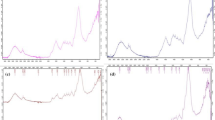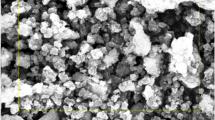Abstract
Dried duckweed-Lm aquatic plant was subjected to molecular modifications using quantum mechanical calculations. The molecular modeling simulates aquatic weed as a composite of cellulose/lignin/glycine. This model suggests the ability to remove inorganic pollutants from wastewater according to unique hydrogen bonding and high total dipole moment. For verifications, experimental efforts are performed for the phytoremediation of Cr (VI) from aqueous solution using a species of Duckweed Lemna minor (Lm) through adsorption process. Duckweed-Lm biomass was prepared and characterized by X-ray diffraction (XRD), scan electron microscope (SEM), Fourier-transform infrared (FTIR) and Brunauer– Emmett–Teller (BET). The effect of several important parameters, such as pH, sorbent dose, contact time, temperature, sorption and desorption processes, was studied. The phytoremediation of Cr(VI) ion was found to be pH-dependent with a maximum removal of 64% achieved at pH of 3.8 and a lowest removal of 25% at pH of 9.5. The obtained adsorption results indicated that duckweed-Lm can be effective for chromium ion removal from aqueous solutions.










Similar content being viewed by others
References
Abbas SH, Ismail IM, Mostafa TM, Sulaymon AH (2014) Biosorption of heavy metals: a review. J Chem Sci Technol 3(4):74–102
Abdel-Gawad FK, Osman O, Bassem SM, Nassar HF, Temraz TA, Elhaes H, Ibrahim M (2018) Spectroscopic analyses and genotoxicity of dioxins in the aquatic environment of Alexandria. Mar Pollut Bull 127:618–625
Abdelsalam H, Elhaes H, Ibrahim MA (2018a) Tuning electronic properties in graphene quantum dots by chemical functionalization: Density functional theory calculations. Chem Phys Lett 695:138–148
Abdelsalam H, Elhaes H, Ibrahim MA (2018b) First principles study of edge carboxylated graphene quantum dots. Phys B 537:77–86
Acar FN, Malkoc E (2004) The removal of chromium (VI) from aqueous solutions by Fagus orientalis L. Biores Technol 94(1):13–15
Alvarez-Ayuso E, Garcia-Sanchez A, Querol X (2007) Adsorption of Cr (VI) from synthetic solutions and electroplating wastewaters on amorphous aluminium oxide. J Hazard Mater 142(1–2):191–198
Arslan G, Pehlivan E (2007) Batch removal of chromium (VI) from aqueous solution by Turkish brown coals. Biores Technol 98(15):2836–2845
Assirey EAR, Ali MEM, Ammar NS, Ibrahim HS, Ibrahim M (2017) Novel Composite for Lead Ions Removal from Wastewater. J Comput Theor Nanosci 14(12):5735–5742
Atta D, Gomaa F, Elhaes H, Ibrahim M (2017) Effect of hydrated dioxin on the physical and geometrical parameters of some amino acids. J Comput Theor Nanosci 14(5):2405–2408
Axtell NR, Sternberg SP, Claussen K (2003) Lead and nickel removal using Microspora and Lemna minor. Biores Technol 89(1):41–48
Badry, R., El-Khodary, S., Elhaes, H., Nada, N., & Ibrahim, M (2019). The Influence of Moisture on the Electronic Properties of Monomer, Dimer, Trimer and Emeraldine Base Sodium Carboxymethyl Cellulose. Egyptian Journal of Chemistry, 62(The First International Conference on Molecular Modeling and Spectroscopy 19–22 February, 2019), 39–56.
Becerra M, Ogle B, Preston TR (1995). Effect of replacing whole boiled soybeans with duckweed (Lemna sp) in the diets of growing ducks. Livest. Res. Rural Dev. 7(2). Retrieved October 15, 2012 from http://www.fao.org/ag/aga/agap/frg/LRRD/LRRD7/3/8.HTM.
Boddu VM, Abburi K, Talbott JL, Smith ED, Haasch R (2008) Removal of arsenic (III) and arsenic (V) from aqueous medium using chitosan-coated biosorbent. Water Res 42(3):633–642
Chen YN, Chai LY, Shu YD (2008) Study of arsenic (V) adsorption on bone char from aqueous solution. J Hazard Mater 160(1):168–172
Dordio A, Carvalho AJP (2013) Constructed wetlands with light expanded clay aggregates for agricultural wastewater treatment. Sci Total Environ 463:454–461
Abdel-Gawad KhF, Khalil WB, Basem SM, Vikas K, Parisi CSI, Temraz TA, Nassar HF, Guerriero G (2020) The Duckweed, Lemna minor Modulates Heavy Metal-Induced Oxidative Stress in the Nile Tilapia. Oreochromis niloticus Water 12(11):2983
Hansen HK, Ribeiro A, Mateus E (2006) Biosorption of arsenic (V) with Lessonia nigrescens. Miner Eng 19(5):486–490
Haque MN, Morrison GM, Perrusquia G, Gutierrez M, Aguilera AF, Cano-Aguilera I, Gardea-Torresdey JL (2007) Characteristics of arsenic adsorption to sorghum biomass. J Hazard Mater 145(1–2):30–35
Ho YS (2006) Isotherms for the sorption of lead onto peat: comparison of linear and non-linear methods. Polish journal of environmental studies 15(1).
Ho YS, Ng JCY, McKay G (2000) Kinetics of pollutant sorption by biosorbents. Sep Purif Methods 29(2):189–232
Hlophe SN, Moyo NAG (2011) The effect of different plant diets on the growth performance, gastric evacuation rate and carcass composition of Tilapia rendalli. Asian J Anim Veter Adv 6(10):1001–1009
Ibrahim M, Kholmurodov KT, Fadeikina IN, Morzhuhina SV, Popova ES, Elhaes H, Mahmoud AA (2017) On the molecular modelling structure of the egyptian soil/sediment in river nile delta region. J Comput Theor Nanosci 14(8):4133–4136
Kalita P, Mukhopadhyay PK, Mukherjee AK (2008) Supplementation of four non-conventional aquatic weeds to the basal diet of Catla catla and Cirrhinus mrigala fingerlings: effect on growth, protein utilization and body composition of fish. Acta Ichthyol Piscat 38(1):21–27
Kamala CT, Chu KH, Chary NS, Pandey PK, Ramesh SL, Sastry ARK, Sekhar KC (2005) Removal of arsenic (III) from aqueous solutions using fresh and immobilized plant biomass. Water Res 39(13):2815–2826
Khanum J, Chwalibog A, Huque KS (2005) Study on digestibility and feeding systems of duckweed in growing ducks. Livest Res Rural Dev 17(5):50
Kumari P, Sharma P, Srivastava S, Srivastava MM (2006) Biosorption studies on shelled Moringa oleifera Lamarck seed powder: removal and recovery of arsenic from aqueous system. Int J Miner Process 78(3):131–139
Luna Zaragoza D, Romero Guzmán ET, Reyes Gutiérrez LR (2009) Surface and physicochemical characterization of phosphates vivianite, Fe2 (PO4) 3 and hydroxyapatite, Ca5 (PO4) 3OH. J Miner Mater Characteriz Eng 8:651–669
Men BX, Ogle B, Lindberg JE (2001) Use of duckweed as a protein supplement for growing ducks. Anim Sci 14(12):1741–1746
Maji SK, Pal A, Pal T, Adak A (2007) Adsorption thermodynamics of arsenic on laterite soil. J Surf Sci Technol 23(3/4):161
Minamisawa M, Minamisawa H, Yoshida S, Takai N (2004) Adsorption behavior of heavy metals on biomaterials. J Agric Food Chem 52(18):5606–5611
Nasr FA, Doma HS, Nassar HF (2007) Treatment of domestic wastewater using Anaerobic Baffled Reactor followed by duckweed pond for Agricultural purposes. Environmentalist 29:270–279
Nassar HF, Shaban MA, Bassem MS, Abdel-Gawad KhF (2015) Utilization of duckweed in nutrient removal from agricultural waste water and producing alternative economic animal fodder. Der Pharma Chemica 7(12):280–285
Nigam M, Rajoriya S, Singh SR, Kumar P (2019) Adsorption of Cr (VI) ion from tannery wastewater on tea waste: kinetics, equilibrium and thermodynamics studies. J Environ Chem Eng 7(3):103188
Nuamah E (2017) Chemical and nutritional composition of Duckweed and its potential as source of feed in broiler production. Anim Feed Nutr. https://doi.org/10.13140/RG.2.2.26734.72005
Oguz E, Ersoy M (2014) Biosorption of cobalt (II) with sunflower biomass from aqueous solutions in a fixed bed column and neural networks modeling. Ecotoxicol Environ Saf 99:2422–2844
Pedraza G, Conde N, Chara J (1996) Evaluacion de un sistema de descontaminacion de agues a traves de la producccion de organismos y plantas acuaticas. Cali, Report CIPAV, p 106
Pokhrel D, Viraraghavan T (2006) Arsenic removal from an aqueous solution by a modified fungal biomass. Water Res 40(3):549–552
Politzer P, Laurence PR, Jayasuriya K (1985) Molecular electrostatic potentials: an effective tool for the elucidation of biochemical phenomena. Environ Health Perspect 61:191–202
Politzer P, Murray JS (1996) Molecular electrostatic potentials: concepts and applications. J Theor Comput Chem 3:634–649
Rajoriya S, Haquiqi A, Chauhan B, Tyagi G, Pundir AS, Jain AK, Agarwal D (2020) Adsorption studies on the removal of hexavalent chromium (Cr (VI)) from aqueous solution using black gram husk. J Environ Treat Tech 8:1144–1150
Şahin ZS, Şenöz H, Tezcan H, Büyükgüngör O (2015) Synthesis, spectral analysis, structural elucidation and quantum chemical studies of (E)-methyl-4-[(2-phenylhydrazono) methyl] benzoate. Spectrochim Acta A 143:91–100
Sarı A, Tuzen M (2009) Biosorption of As (III) and As (V) from aqueous solution by macrofungus (Inonotus hispidus) biomass: equilibrium and kinetic studies. J Hazard Mater 164(2–3):1372–1378
Sasmaz A, Obek E (2009) The accumulation of arsenic, uranium, and boron in Lemna gibba L. exposed to secondary effluents. Ecol Eng 35(10):1564–1567
Saygideger S, Gulnaz O, Istifli ES, Yucel N (2005) Adsorption of Cd (II), Cu (II) and Ni (II) ions by Lemna minor L.: effect of physicochemical environment. J Hazard Mater 126(1–3):96–104
Stewart JJP (2008) MO-G Version 1.1 A. Fujitsu Limited, Tokyo, Japan
de Tavares F, A, Roudrigues JSR, Fracalossi DM, Esquivel J, Roubach R, (2008) Dried duckweed and commercial feed promote adequate growth performance of tilapia fingerlings. Biotemas 21(3):91–97
Tavares FFR, Lapolli R, Roubach MK, Jungles DM, Fracalossi AM (2010) Use of domestic effluent through duckweeds and red tilapia farming in integrated system. Pan-Am J Aquat Sci 5:1–10
Velásquez L, Dussan J (2009) Biosorption and bioaccumulation of heavy metals on dead and living biomass of Bacillus sphaericus. J Hazard Mater 167(1–3):713–716
Zhou D, Zhang L, Guo S (2005) Mechanisms of lead biosorption on cellulose/chitin beads. Water Res 39(16):3755–3762
Acknowledgements
This research was supported in part by central laboratory, the laboratory of environmental science and industrial development department, faculty of post graduate studies for advanced sciences, Beni-Suef University and the laboratory of spectroscopy department at National Research Centre.
Author information
Authors and Affiliations
Corresponding author
Rights and permissions
About this article
Cite this article
Nassar, H.F., Ibrahim, M. Duckweed-lemna minor as green route for removal of chromium (VI) from aqueous solution. Int J Environ Res 15, 275–284 (2021). https://doi.org/10.1007/s41742-021-00314-4
Received:
Revised:
Accepted:
Published:
Issue Date:
DOI: https://doi.org/10.1007/s41742-021-00314-4




